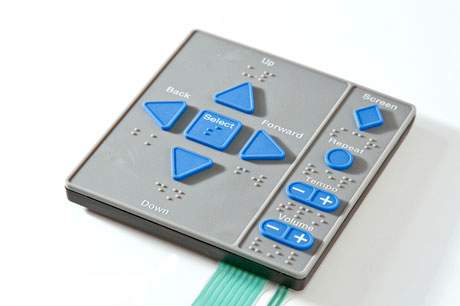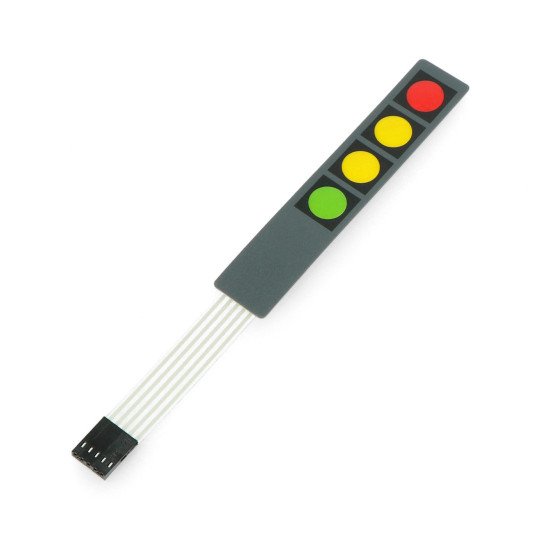Membrane Switch Manufacturer with Rapid Prototyping and Lead Time
Membrane Switch Manufacturer with Rapid Prototyping and Lead Time
Blog Article
Checking Out the Production Refine of Membrane Switch for Numerous Industries
The manufacturing process of Membrane switches is a complex undertaking that requires accuracy and attention to detail. From selecting proper materials to executing rigorous high quality control actions, each action plays a vital duty in making certain capability. Numerous sectors, consisting of clinical and vehicle, count on these components for their special applications. Understanding the intricacies of this process reveals substantial insights right into how these buttons are created and their impact across diverse industries.
Comprehending Membrane Switches: A Review

Secret Products Used in Membrane Switch Production
In Membrane switch manufacturing, the choice of key materials substantially affects functionality and resilience. Conductive materials, adhesives, and finishes play important roles, while substrate choice impacts overall efficiency and dependability. Recognizing these parts is essential for enhancing the layout and production of Membrane buttons.
Conductive Materials Introduction
Conductive products play an important function in the functionality of Membrane buttons, ensuring trusted electrical connections within the gadget. Frequently utilized materials consist of silver, copper, and carbon-based inks, each offering unique benefits. Silver is favored for its high conductivity and resilience, making it ideal for applications calling for robust performance. Copper, while slightly much less conductive than silver, is a cost-effective choice typically utilized in printed circuits. Carbon-based inks provide a flexible alternative, ideal for applications where versatility and lower costs are prioritized, although they have lower conductivity contrasted to steel choices. The option of conductive materials directly affects the overall dependability, life expectancy, and efficiency of the Membrane switch, making it an essential factor to consider in the production procedure.
Adhesives and Coatings
Layers and adhesives are crucial components in the manufacturing of Membrane buttons, giving vital bonding and protective residential properties. These products guarantee that different layers of the switch, consisting of graphic overlays and wiring, adhere safely to each other, boosting sturdiness and performance. Generally used adhesives consist of pressure-sensitive adhesives (PSAs) and epoxy-based formulations, which use strong adhesion and resilience. Coatings, such as polyurethane or acrylic, serve to protect against ecological elements, consisting of dampness, abrasion, and chemicals. Furthermore, coverings can improve responsive comments and aesthetic allure, adding to the general customer experience. The choice of suitable adhesives and layers is crucial for optimizing efficiency and long life in diverse applications throughout numerous industries, ensuring that Membrane changes satisfy specific functional demands.
Substrate Selection Variables
Substratum selection plays a vital function in the manufacturing of Membrane buttons, as it greatly influences their overall performance and longevity. Trick products such as polyester, polycarbonate, and versatile printed circuit boards (FPCBs) are frequently utilized for their distinctive homes. Polyester is preferred for its cost-effectiveness and resistance to abrasion, making it appropriate for applications with high wear. Polycarbonate offers exceptional clearness and effect resistance, ideal for atmospheres requiring high exposure. FPCBs give improved versatility and are often used in intricate designs. The choice of substratum likewise influences elements like thermal security, chemical resistance, and convenience of printing. Ultimately, selecting the ideal substrate is vital for guaranteeing the performance and long life of Membrane switches across different industries.
The Layout Refine of Membrane Switches Over
The design process of Membrane buttons is a critical stage that considerably influences the performance and looks of the end product - membrane switch manufacturer. It begins with specifying the particular needs of the application, consisting of measurements, switch design, and responsive comments choices. Developers need to take into consideration user communication, making sure that the button is instinctive and accessible.Next, products are selected based upon longevity, versatility, and environmental resistance. The combination of graphics and branding elements is likewise essential, as it enhances visual appeal and communication. Prototyping enables repetitive testing, enabling modifications based upon individual feedback and efficiency evaluations.Additionally, the style should represent the electric elements, such as connectors and circuits, guaranteeing integrity and ease of usage. Eventually, a successful style integrates performance, appearances, and customer experience, paving the way for efficient manufacturing and durable efficiency in numerous sectors
Printing Techniques for Membrane Changes
The printing strategies used in Membrane button Get More Info production play a crucial role in establishing the last item's high quality and capability. Screen printing provides benefits such as durability and dynamic color application, while electronic printing advancements give versatility and accuracy in style. Recognizing these techniques can greatly impact the total performance of Membrane buttons in various applications.
Display Printing Benefits
Many advantages make screen publishing a recommended strategy for producing Membrane buttons. This approach enables top quality, dynamic shades and detailed designs, which are crucial for user interface applications. Screen printing is particularly effective for applying thick ink layers, improving resilience and tactile comments. Additionally, it provides excellent attachment to different substratums, ensuring durability in demanding settings. The procedure is economical for huge manufacturing runs, as it decreases setup time and waste. Furthermore, screen printing supports a variety of inks, including specialized and UV-curable alternatives, making it possible for flexibility in design. Its capacity to generate regular outcomes throughout numerous units makes it a reputable option for makers intending for quality and effectiveness in Membrane button production.
Digital Printing Innovations

Developments in digital printing technology are transforming the production of Membrane switches, offering makers innovative services that boost design flexibility and efficiency. Digital printing permits detailed designs and high-resolution graphics, enabling custom branding and performance without the restrictions of conventional techniques. This technique lowers arrangement times and expenses, assisting in much shorter manufacturing runs and marginal waste, making it optimal for organizations with varying demands. Additionally, developments in ink solutions give better sturdiness and adhesion, ensuring long life in various settings. As markets significantly seek intricate and tailored styles, electronic printing stands apart as a necessary strategy, establishing a brand-new requirement in Membrane switch manufacturing. The integration of these technologies settings producers to satisfy advancing market needs efficiently.
Setting up and Layering of Membrane Switch Components
Cautious assembly and layering of Membrane switch parts are necessary to guaranteeing functionality and durability. This process begins with the precise positioning of different layers, consisting of the graphic overlay, adhesive, circuit layer, and backing product. Each part should be thoroughly positioned to keep electric stability and user interface responsiveness.During setting up, conductive traces are put on the circuit layer, typically made from products like polyester or polycarbonate. This layer is critical, as it transmits signals when stress is applied. The sticky made use of for bonding these layers is also picked for its ability to withstand environmental stresses while keeping a safe bond.Heat and stress are often used during the setting up procedure to identify that the layers stick correctly without jeopardizing the performance of the button. Ultimately, focus is offered to the edge sealing to shield against dampness and contaminants, protecting the durability of the Membrane button in numerous commercial applications.
Quality Assurance Steps in Membrane Switch Production
Quality assurance measures play an important duty in making certain the dependability and efficiency of Membrane switches over complying with the assembly and layering of their elements. In the manufacturing procedure, a number of essential evaluations are performed to maintain top quality criteria. These consist of aesthetic evaluations for problems in printing and glue application, as well as practical examinations to validate the responsiveness of each switch.Additionally, environmental screening is executed to examine the switches' durability versus temperature level changes and humidity exposure. Makers commonly execute statistical process control (copyright) techniques to monitor production uniformity, enabling early discovery of anomalies.Furthermore, traceability systems are developed to track parts and materials, making certain liability and helping with remembers if essential. Calibration of tools and adherence to sector standards are also crucial to maintaining item integrity. Jointly, these quality assurance steps guard the performance of Membrane changes across different applications, ultimately boosting customer fulfillment.
Applications of Membrane Changes Throughout Different Industries
Membrane buttons are made use of across a diverse array of sectors, showcasing their versatility and adaptability. In the medical field, they offer reputable and waterproof interfaces for gadgets such as analysis devices and mixture pumps, ensuring health and convenience of usage. The auto sector employs Membrane buttons for dashboard controls, making it possible for smooth interaction between the chauffeur and automobile systems.In customer electronics, these buttons are found in home appliances and handheld gadgets, offering a smooth, contemporary visual while enhancing capability. Industrial applications also leverage Membrane changes for equipment control panels, where toughness and resistance to severe conditions are this content essential.Furthermore, the aerospace and protection sectors utilize Membrane buttons for cockpit instrumentation and interaction systems, focusing on reliability and efficiency under severe problems. In general, Membrane buttons play a vital role in boosting the customer experience and operational efficiency across various domain names.
Frequently Asked Inquiries
The length of time Does It Take to Manufacture a Membrane Layer Switch?
The manufacturing time for a membrane button usually varies from a couple of days to a number of weeks - membrane switch manufacturer. Elements influencing this duration consist of style complexity, product availability, and production volume, all influencing the total timeline significantly
What Is the Common Life-span of a Membrane Layer Switch?
The common life-span of a membrane switch usually ranges from 1 to 5 million actuations, relying on elements such as worldly quality, environmental problems, and use frequency, significantly influencing resilience and total performance.
Can Membrane Changes Be Custom-made for Particular Applications?
Membrane switches can undoubtedly be customized for specific applications. Their style versatility enables why not try these out alterations in size, form, colors, and graphics, making certain compatibility with distinct needs across numerous sectors and boosting performance and customer experience.

Are Membrane Changes Eco-friendly?
The ecological impact of Membrane switches differs. Some products made use of might not be eco-friendly, while improvements in producing processes are increasingly focusing on sustainability, intending to lower waste and advertise recyclable components in their manufacturing.
What Are the Typical Failing Modes of Membrane Switches?
Typical failure modes of Membrane switches include delamination, sticky failure, damage from usage, moisture access, and electric failures. These problems can substantially impact performance, efficiency, and life-span in different applications throughout various industries. Membrane buttons can be personalized to fit certain layout needs, such as performance, size, and shape, making them highly adaptable.The building usually involves numerous layers, consisting of a graphic overlay, adhesive, and a circuit layer, which work with each other to develop a smooth customer experience. In Membrane button manufacturing, the selection of key materials substantially affects functionality and resilience. The automotive industry utilizes Membrane switches for dashboard controls, enabling seamless communication between the chauffeur and lorry systems.In consumer electronics, these switches are discovered in appliances and portable devices, offering a sleek, modern aesthetic while improving functionality. Industrial applications additionally utilize Membrane switches over for equipment control panels, where toughness and resistance to harsh conditions are essential.Furthermore, the aerospace and protection industries make use of Membrane buttons for cabin instrumentation and interaction systems, prioritizing integrity and efficiency under extreme conditions. Membrane buttons can certainly be customized for specific applications.
Report this page